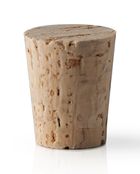Cork: Difference between revisions
Jump to navigation
Jump to search
Uncle Jesse (talk | contribs) (Creating page) |
Uncle Jesse (talk | contribs) (Adding image) |
||
| Line 1: | Line 1: | ||
[[file:cork.jpg|thumb|140px|right|Typical Cork]] | |||
[[Bottle]] closure made from the bark of cork oaks (''Quercus Suber''). Quality corks have very fine [[Grain|grain]], only minor or no faults, good compressability, and have been cured to contain between 5 and 8% moisture. | [[Bottle]] closure made from the bark of cork oaks (''Quercus Suber''). Quality corks have very fine [[Grain|grain]], only minor or no faults, good compressability, and have been cured to contain between 5 and 8% moisture. | ||
Revision as of 00:49, 16 September 2017
Bottle closure made from the bark of cork oaks (Quercus Suber). Quality corks have very fine grain, only minor or no faults, good compressability, and have been cured to contain between 5 and 8% moisture.
If you are looking to use a cork to close your bottles, slightly used wine corks can be made into great spirit corks. Corks from a hardware store can be a bit overpriced (~$0.30-$0.50US). Its easy to turn a wine cork into a spirit by cutting the cork in half lengthwise and then tapering down one end. A straight razor or pocket knife is often the ideal tool for the job.
